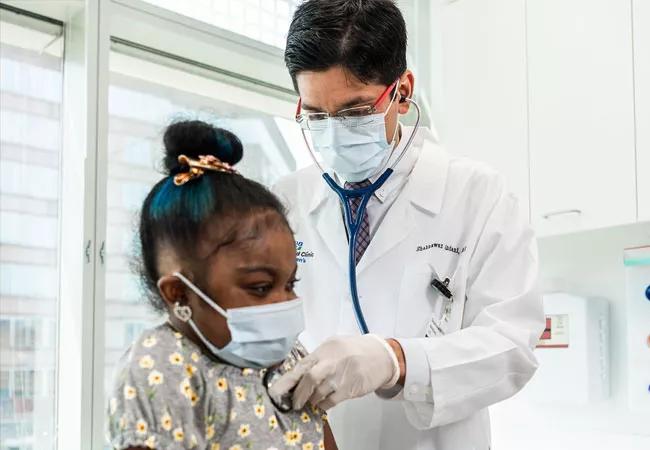Advertisement
Study shows waitlist and post-transplant outcomes haven’t improved in 30 years

Children with myocarditis who are listed for a heart transplant (HT) are generally sicker and have worse outcomes than those with dilated cardiomyopathy (DCM), according to the findings of a recent multicenter study published in the Journal of Heart and Lung Transplantation.
Advertisement
Cleveland Clinic is a non-profit academic medical center. Advertising on our site helps support our mission. We do not endorse non-Cleveland Clinic products or services. Policy
Perhaps “most disturbing,” says study author Shahnawaz Amdani, MD, a pediatric heart failure and transplant cardiologist, is that waitlist and post-transplant outcomes in children with myocarditis have not improved in the last 30 years.
Further, recent reports have shown that transplant outcomes are improving in patients with DCM, non-DCM and congenital heart disease in the modern era.
“Outcomes for all other pediatric heart failure diagnoses have improved, except for myocarditis. So that’s something we need to pay attention to because the current allocation policy does not take this into account,” says Dr. Amdani.
The authors say that current transplant outcomes data on children with myocarditis are limited and conflicting. Therefore, they sought to lead a comprehensive analysis of this patient population and compare them to outcomes for children with DCM over the same period.
The research team tapped into the Pediatric Heart Transplant Society (PHTS), a prospective heart transplant database that includes detailed pre-and postoperative information on patients undergoing HT since 1993.
A previous study from the PHTS and the Pediatric Cardiomyopathy Registry found that children with myocarditis had significantly worse survival outcomes following transplant as compared to those without myocarditis, including more frequent death from graft rejection. The authors of this prior study concluded that the diagnosis might pose an independent risk for post-HT mortality and raised the possibility of an immune mediated phenomenon adversely impacting graft survival.
Advertisement
A different study that used the Organ Procurement and Transplant Network database, similarly, showed that children with myocarditis were generally sicker at the time of listing. However, after adjusting for the severity of the illness, the authors concluded that myocarditis did not independently confer additional risk to waitlist or post-HT morality.
“Given the contradictions in these findings, we decided to leverage this large dataset and take a closer look at myocarditis and heart transplant data over the last 30 years to answer some clinically meaningful questions,” says Dr. Amdani. “To our knowledge, this is the most comprehensive analysis of heart transplant outcomes in children with myocarditis.”
The team analyzed data from 9,755 PHTS-listed patients from 1993 to 2019, primarily including those with myocarditis (N = 322) and those with dilated cardiomyopathy (DCM) (N = 3,280).
“Because of the available data and level of granularity, we divided the patients into three buckets: those with myocarditis, those with DCM, and a smaller subset, not included in the primary analysis, patients that developed DCM after myocarditis,” he explains.
They further divided these cohorts into patients listed and transplanted in the early era, from 1993 to 2008, and in the current era, from 2009 to 2019, to evaluate outcomes over time.
The researchers examined four domains: (1) clinical and demographic characteristics between children with myocarditis and DCM in early and current eras, (2) waitlist survival differences for children with myocarditis compared to those with DCM, (3) post-heart transplant outcomes between children with myocarditis and those with DCM and (4) risk factors for waitlist and post-heart transplant mortality in those listed for transplant. The analysis yielded the following findings.
Advertisement
Given the improvements in transplant outcomes among other heart failure diagnoses, Dr. Amdani says the findings are sobering and show that little progress has been made to improve outcomes for this patient population.
However, he is hopeful that parsing out these details will lay a foundation for changing policy that prioritizes these patients’ access to transplant and developing more targeted interventions in their care.
“Patients with myocarditis are still sicker at heart transplant listing. They’re still sicker at the time of transplant. They’re still more likely to die early after a heart transplant. So, again, we need to revise our policies to ensure equity in terms of either higher urgency for transplant or in terms of how they’re treated in the context of the other diagnoses,” concludes Dr. Amdani.
Advertisement
Advertisement

Science advisory examines challenges, ethical considerations and future directions

Large registry study explores association between statin use and long-term outcomes

Panel proposes staging and treatment protocols that support harmonized evaluation and management of heart failure in patients with congenital heart disease

Study examines data and clinical implications for performing Ross procedures in infancy versus later in life

Eminent clinician-researcher brings special expertise in nutritional interventions for heart failure

Recent volume and outcomes data in two major realms of cardiovascular care

Updated guidance and a call to action

Cleveland Clinic case series demonstrates feasibility and safety in diverse patients